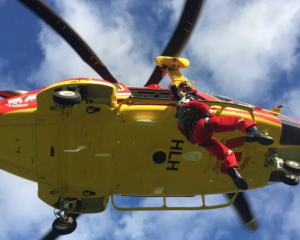
Sir David Attenborough has lent his star power to an ambitious new plan to document our unrecorded species before they become extinct.
The plan, being launched in Canberra today, aims to describe within 10 years the yet-to-be-found proportion of New Zealand and Australia's biodiversity, which best estimates have put at 70%.
With 56,200 living species and 14,700 fossil species already named, New Zealand boasts one of the most comprehensive natural inventories on the planet.
But countless plants and animals are waiting to be formally described by scientists and there are fears scores could become extinct before they can be catalogued.
In New Zealand over the past 800 years, humans and their accompanying pests have brought about the extinction of 32% of indigenous land and freshwater birds, 18% of endemic seabirds, three of seven frogs, at least 12 invertebrates, possibly 11 plants, a fish, a bat and perhaps three known reptiles.
Today, about 1000 of our known animal, plant and fungi species are considered threatened.

The new effort has been applauded by Sir David, who said the two countries had "some of the most extraordinary organisms anywhere on Earth" and called for greater support for the scientists who study and name biodiversity.
"Taxonomists and biosystematists build the system, the species and their relationships, on which much of biology, conservation, ecology - and nature documentaries - depend," the famed naturalist and broadcaster said.
"We cannot properly grasp or understand the natural world without this taxonomic system. Every time I show the world a species and its life, I depend on the work of these scientists.
"And yet, in countries the world over, at the very time that many species are under greatest threat, funding and other resources allocated to the task of discovering, naming and documenting nature are declining."
The project has been developed by New Zealand's Royal Society Te Aparangi and the Australian Academy of Sciences.
The Australian plant taxonomist leading it, Dr Kevin Thiele, believed we could completely document our biodiversity within a generation if enough time and resources were thrown into the work.
"A substantial increase in the current rate is possible if taxonomists and biosystematists are properly supported to take advantage of the technological revolution underway, in areas such as genomics, machine learning and 3D imaging, which would help speed up the mapping of our unique biodiversity," Thiele said.
The plan follows an exhaustive review of taxonomic collections in New Zealand, published by Royal Society Te Aparangi in 2015, which also called for more resources.
"Following New Zealand's 2015 report, we are making progress in New Zealand for maintaining and building capacity in taxonomy," said that review's chair, Professor Wendy Nelson of Niwa and the University of Auckland.
Taxonomy had since featured more prominently in national science strategies and government work programmes, and a new Te Papa-hosted group had brought together 13 institutions that held more than 90% of New Zealand's collections.
Auckland War Memorial Museum head of natural sciences Dr Tom Trnski, who is helping steer the new plan, said support for such work had "declined significantly" during the past three decades, which hampered our ability to deal with biosecurity risks or simply understand what we had.
In 2015, it was estimated $12.5 million was being spent here annually to cover staffing, materials, housing and overheads in the larger biodiversity collections, with investment coming from a mix of sources.
That compared with the estimated $100m cost involved in a relatively harmless bacterium being mis-identified in 2013 as the potentially fatal C. botulinum, resulting in a mass recall of New Zealand export milk products.
Trnski noted the plan called for a new funded body to help species discovery.
"This would reverse the erosion of taxonomic knowledge available in New Zealand, and provide career pathways for young taxonomists."
- By Jamie Morton












